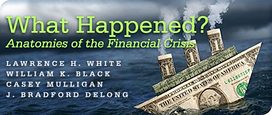Brad DeLong rejects “the claim that the crash in the mortgage market was in some sense the fault of excessively risky lending by the GSEs Fannie Mae and Freddie Mac which pulled the private sector along behind them,” based on the observation that “Fannie Mae and Freddie Mac lost market share as all the loans that have now gone bad were made.” Presumably “all the loans that have now gone bad” refers to the nonprime and ARM loans made between 2004 and 2007. He concludes that there must have been “a reduction in demand for Fannie Mae and Freddie Mac’s products” and that “the dominant feature of the mortgage market in the 2000s was not an expansion of supply by Fannie Mae and Freddie Mac pushing their implicit government guarantee past the limits of prudence.”
Professor DeLong presents his argument as an application of the logic of supply and demand. But supply and demand curves deal with prices and quantities, not prices and market shares. In a booming market, a declining market share is consistent with a growing contribution to supply (a continuing rightward shift in the firm’s supply curve). His unlabeled chart of market shares, moreover, appears to depict total mortgage market shares, whereas the claim in question is about “excessively risky lending” rather than total mortgage lending.
Fannie Mae and Freddie Mac were in fact expanding their quantities of nonprime mortgages vigorously from late 2004 to 2007. After parsing the GSEs’ financial statements, Peter Wallison of the American Enterprise Institute finds that:
From 2005 to 2007, Fannie and Freddie bought approximately $1 trillion in subprime and Alt-A loans, amounting to about 40 percent of their mortgage purchases during that period.
The GSEs thus importantly contributed to the overall supply of nonprime mortgage financing, prompting mortgage brokers to originate more nonprime mortgages. The increased ability to sell nonprime mortgages to the GSEs and their competitors encouraged mortgage originators to dig deeper into the barrel of applicants to accept more of those previously considered non-creditworthy.
Wallison and Charles Calomiris add that:
Although a large share of the subprime loans now causing a crisis in the international financial markets are so-called private label securities — issued by banks and securitizers other than Fannie Mae and Freddie Mac — the two GSEs became the biggest buyers of the AAA tranches of these subprime pools in 2005-07. Without their commitment to purchase the AAA tranches of these securitizations, it is unlikely that the pools could have been formed and marketed around the world. Accordingly, not only did the GSEs destroy their own financial condition with their excessive purchases of subprime loans in the three-year period from 2005 to 2007, but they also played a major role in weakening or destroying the solvency and stability of other financial institutions and investors in the United States and abroad.
As to total mortgage lending from 2000 to 2005, below is a chart released in 2006 [pdf] by James B. Lockhart III, then Director of the Office of Federal Housing Enterprise Oversight, Fannie and Freddie’s regulator. It shows the steady expansion in their quantities of mortgage-backed securities outstanding through 2005:

Regarding their total portfolios, Lockhart notes:
Fannie Mae’s mortgage assets grew from about $124 billion in 1990 to $905 billion in 2004, and then declined to about $727 billion last year. That’s equivalent to average annual growth of more than 13 percent over the 15-year period… . Freddie Mac’s mortgage portfolio grew 26 percent per annum from less than $22 billion at year-end 1990 to $710 billion in 2005. In contrast, the residential mortgage market grew at an average rate of 8.5 percent.
Except for 2004 in the case of Fannie Mae, it is clear that this pattern is not consistent with “a reduction in demand for Fannie Mae and Freddie Mac’s products” dominating over increases in supply. Quantities supplied increased. They especially increased for nonprime products.
It is thus reasonable to think that the crash in the mortgage market was “in some sense,” i.e. to some extent, the fault of excessively risky lending by Fannie Mae and Freddie Mac. Whether or not we call it “the dominant feature of the mortgage market in the 2000s” (emphasis added), it is safe to say that it was an important feature. Fannie Mae and Freddie Mac did push the lending financed by their implicit government guarantee “past the limits of prudence.”

